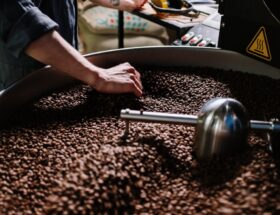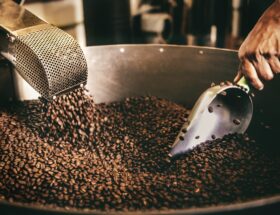
The Science Behind Coffee Bloom and Its Impact on Flavor
Coffee bloom, also known as coffee blooming or degassing, refers to the release of carbon dioxide gas that occurs during the brewing process. This natural phenomenon plays a crucial role in extracting the rich flavors from coffee beans and can significantly influence the overall taste of your cup. Join us as we dive into the science behind coffee bloom and provide insights on how to achieve the perfect bloom every time, resulting in a truly exceptional coffee experience.
Table of Contents
What is Coffee Bloom and Why is it Important?
Coffee bloom refers to the release of trapped gases from freshly roasted coffee grounds when hot water is poured over them during the brewing process. It is an essential and fascinating step in the coffee brewing technique that greatly impacts the flavor and aroma of your cup of joe.
During coffee bloom, a delicious chemical reaction takes place as the hot water saturates the coffee grounds, causing them to release carbon dioxide (CO2) and various volatile compounds. This bloom, when done correctly, signifies that the coffee beans are fresh and of high quality. It is crucial for extracting the optimal flavors and ensures a well-balanced and aromatic brew.
Did you know that the coffee bloom is actually the release of carbon dioxide gas from the freshly roasted coffee beans? This carbon dioxide is trapped within the beans during the roasting process and is released when the beans come in contact with water during brewing. The bloom is an indicator of freshness, ensuring that you get the best possible flavor from your coffee.
The Science Behind Coffee Bloom and Its Impact on Flavor
Have you ever wondered why coffee professionals across the globe pay so much attention to coffee bloom? It turns out that this seemingly simple process has a significant impact on the flavor and quality of your cup of joe. In this blog post, we will dive into the science behind coffee bloom and explain why it matters in the brewing process.
Coffee Bloom Explanation
What exactly is coffee bloom? During the blooming process, freshly roasted coffee grounds release gases trapped inside them, leading to the formation of tiny bubbles on the surface. These bubbles are carbon dioxide gas escaping from the coffee.
The release of carbon dioxide is a result of the chemical reactions that occur within the coffee beans during the roasting process. As the beans heat up, moisture inside them evaporates, creating pressure. When this pressure builds up and is released upon contact with water, it causes the coffee bloom.
Coffee Chemistry: Flavor Extraction
Coffee bloom plays a crucial role in flavor extraction during the brewing process. When water comes into contact with coffee grounds, it acts as a solvent, extracting compounds from the beans. The carbon dioxide released during bloom helps to agitate the coffee grounds, allowing for better extraction of flavors.
During the bloom, the carbon dioxide forms a barrier between the coffee grounds and the water, preventing it from flowing through too quickly. This process ensures that the water is in contact with the coffee for a sufficient amount of time, allowing the extraction of desirable compounds responsible for the coffee’s taste.
Coffee Brewing Techniques for the Perfect Bloom
Now that we understand the importance of coffee bloom, how can we achieve the perfect bloom every time? Here are a few tips:
- Use freshly roasted coffee beans: Freshly roasted beans retain more carbon dioxide, resulting in a better bloom.
- Grind your coffee just before brewing: Ground coffee quickly loses carbon dioxide, so grinding it right before brewing ensures a more vibrant bloom.
- Use the right water temperature: Optimal water temperature for bloom is around 195-205°F (90-96°C). This temperature range helps extract flavors effectively.
- Practice bloom timing: Allow the coffee to bloom for about 30 seconds before continuing with the rest of the brewing process. This gives enough time for gas release and flavor extraction.
By implementing these techniques, you can enhance the flavor and aroma of your coffee and ensure a delightful brewing experience.
The science behind coffee bloom is fascinating. Understanding the chemical processes that occur during coffee bloom and its impact on flavor extraction empowers coffee enthusiasts to make better brewing decisions. Remember to pay attention to the bloom stage of your brewing process to achieve a more flavorful and satisfying cup of coffee. Happy brewing!
Step-by-Step Guide to Achieving a Perfect Coffee Bloom
Step 1: Start with Freshly Roasted Coffee Beans
For the best coffee bloom, it is important to use freshly roasted coffee beans. Look for beans that have been roasted within the past two weeks to ensure optimal flavor extraction. Old beans may not bloom as well due to the loss of carbon dioxide gas.
Step 2: Grind Your Coffee Beans
Grind your coffee beans right before brewing for the freshest flavor. Use a burr grinder to achieve a consistent grind size. Aim for a medium-coarse grind, similar to sea salt, which allows for the ideal extraction during blooming.
Step 3: Pre-wet the Coffee Grounds
Pre-wetting the coffee grounds helps to kickstart the blooming process. Place your brewing apparatus, such as a pour-over cone or French press, atop your coffee mug or carafe. Pour just enough hot water (around twice the weight of the coffee) over the grounds to wet them completely. Allow the coffee to bloom for about 30 seconds.
Step 4: Observe the Bloom
Watch as the coffee grounds bubble and expand during the blooming process. This is the release of trapped carbon dioxide, which is a natural byproduct of coffee roasting. The bloom should rise like a beautiful flower, indicating that the coffee is fresh and properly blooming.
Step 5: Continue with the Brewing Process
Once the blooming stage is complete, slowly and evenly pour the remaining hot water over the coffee grounds, using circular motions. This technique ensures proper extraction and allows the flavors to develop fully.
Step 6: Enjoy Your Perfectly Brewed Coffee
Allow the brewing process to finish, then grab your favorite mug and savor the flavors of your freshly brewed coffee. Notice the enhanced taste and aroma that the proper blooming process brings to your cup.
Additional Tips:
- Experiment with different coffee-to-water ratios to find your preferred strength.
- Use water at a temperature between 195-205°F (90-96°C) for optimal extraction.
- Invest in a gooseneck kettle for precise pouring control.
- Practice the blooming technique with a variety of brewing methods, such as pour-over, French press, or Chemex.
Wrap Up
In conclusion, understanding the science behind coffee bloom and its impact on flavor is crucial for achieving the perfect cup of coffee. The chemical reactions that occur during coffee bloom play a significant role in extracting the desirable flavors from the beans. By allowing the carbon dioxide to escape and extracting flavors through the blooming process, you can enhance the taste and aroma of your coffee.
To achieve the perfect coffee bloom every time, make sure to use fresh and high-quality beans, grind them just before brewing, use the correct water-to-coffee ratio, and control the brew time and temperature. Experiment with different brewing techniques such as pour-over, French press, or Aeropress to find the method that suits your taste preferences.
We hope this blog post has provided you with valuable insights into coffee bloom and its impact on flavor. Now, go ahead and put your knowledge into practice. Brew a cup of delicious coffee and savor the flavors. Don’t forget to leave a comment below and share your brewing experiences and tips.
For more coffee-related articles and brewing techniques, check out these links:
- TenCoffees
- How to Vietnamese Coffee: The Strong, Bold Coffee
- How to Hario V60: The Ultimate Guide to Making Perfect Coffee
- How to Siphon Coffee: The Slow and Elegant Way to Brew a Perfect Cup
- How to Aeropress: The Ultimate Guide to Making Amazing Coffee at Home
Remember, the key to a great cup of coffee lies in understanding the science and mastering the brewing techniques. Happy brewing!









